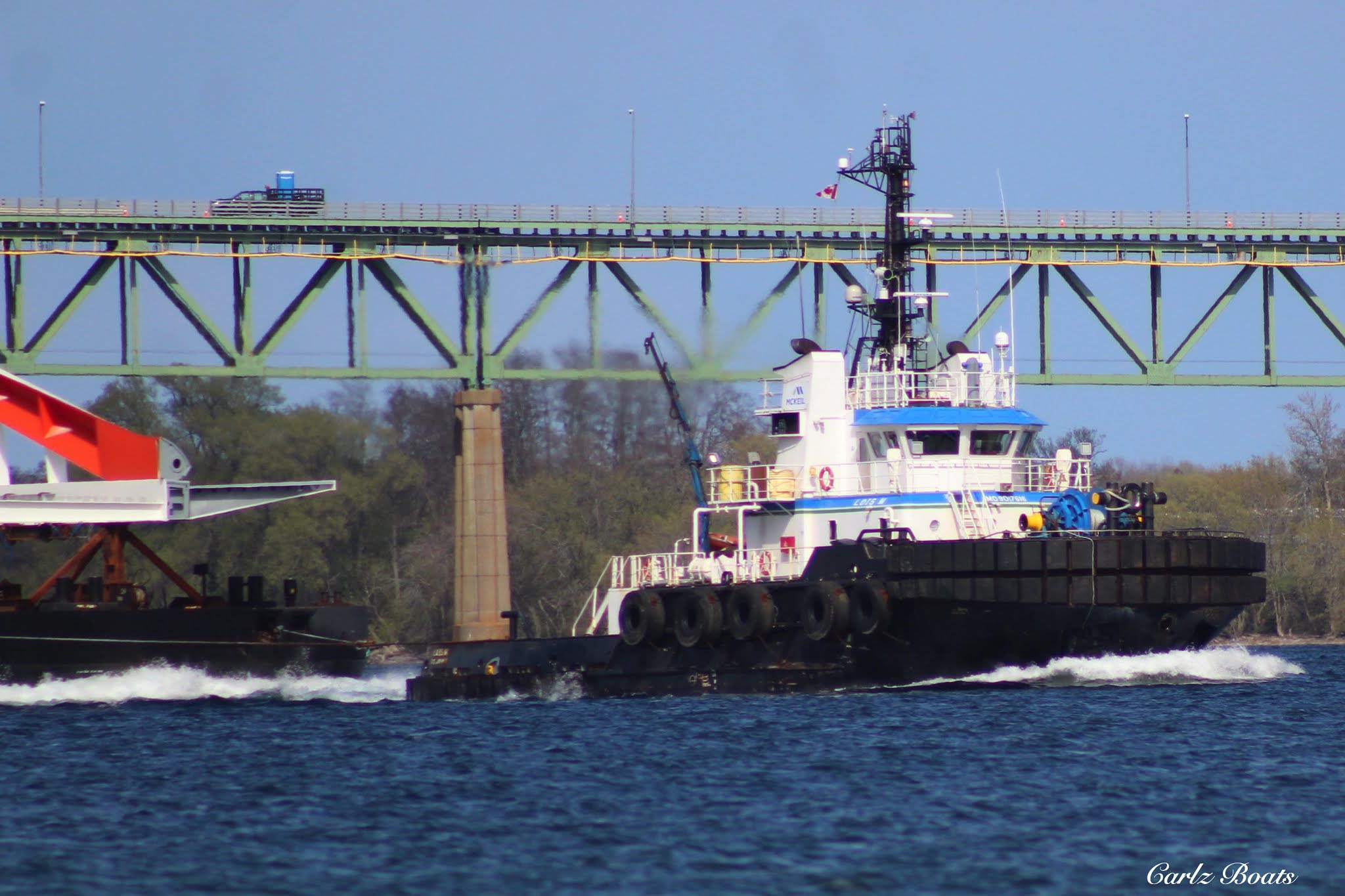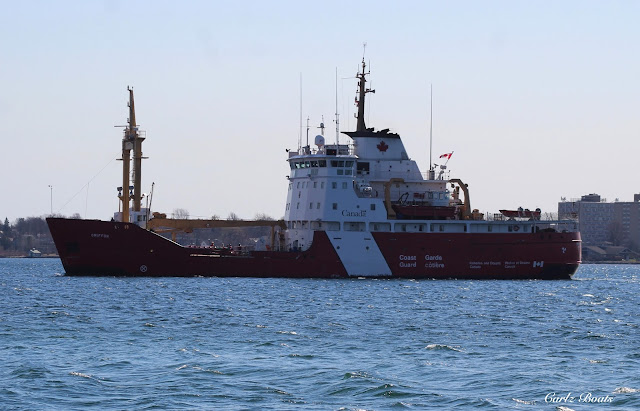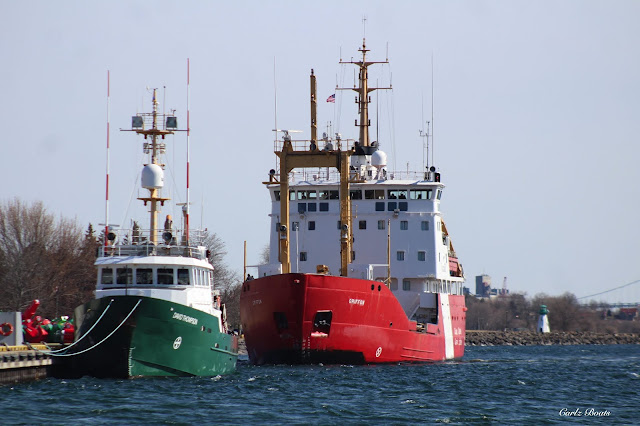Bridges are built to cross
"OVER" things like rivers, so you can appreciate the wonderment when I got to see one on May 10th being transported
"ON" a river and also passing
"BENEATH" one of the tallest and longest suspension bridges on the St. Lawrence Seaway, the Ogdensburg-Prescott International Bridge. While it doesn't happen everyday, it was just a little more than 6 months earlier when the first of 4 bridges, then the Cherry Street North Bridge was also hauled to Toronto from Nova Scotia on the McKeil Marine barge
GLOVERTOWN SPIRIT while lead by their strong tractor tug
LOIS M as well.
 |
Map from waterfrontoronto.ca
|
All built by Cherubini Metal Works of Dartmouth, the 4 prefabricated bridges that will connect the future Villier Island to Toronto mainland as part of the Don Mouth Naturalization and Port Lands Flood Protection Project. Wow, that was a mouthful c):-o. Originally the mouth of the Don River use to become a marsh and flow easterly towards Ashbridge's Bay. In the late 1800's, the marsh and portions of the bay were filled in to attract industries to locate near the new harbour in an area to be known as Toronto Port Lands, and in doing so, the Don was diverted on a 90 degree turn into the Keating Channel before emptying into the harbour west of the current Cherry Street bridge.

Great idea except the bend regularly needed dredging to improve the flow and prevent flooding
in the spring or after a heavy rain. When completed, the new Don River will
be redirected further south and then westward in a meandering flow to it's new mouth into Toronto
Harbour, the Polson Slip which currently is used for layups and where the Lafarge Cement terminal is
currently located, or at least it was the last I was shooting from along Cherry Street about two years ago. That's where I caught the former veteran cement carrier
ENGLISH RIVER at on a cold winter afternoon on January 7, 2018 from the T&T food store parking lot which will also be carved away in the excavation project to make room for the new Cherry Street South Bridge. Also if flooding were to occur during spring run-off, a lower-land valley
is being created so that excess water will flow into the more southern
east-west directed ship channel.
Though the longest of the 4 lookalike spans at 83 metres (272'), the 650
tonne Commissioners Street bridge looked pretty small just the same as
she passed beneath the 1.5 mile (2.4k) long suspension bridge with a
centre span of 1,150' (350m) long.
Once the second section of the span is built and barged to Toronto, the new Commissioners Street Bridge will in fact be 152m (502') long and cross the new naturalized Don River Valley as shown in the map above.
The 107.5'
LOIS M is known as a tractor tug with a twin screw Z-drive propulsion system. The 79-tonne bollard pull harbour and coastal
towing tug has 2 Niigata engines giving her 4800 bhp,
When built in 1991 at Matsurra
Tekko Shipyard in Higashino, Japan for Cleveland Cliffs-Robe River Iron in
Australia her name was
LAMBERT. In 2014 she was sold to McKeil Marine of Hamilton and renamed
LOIS M.
Built 2012 at Damen Shipyards, in Grichem, Netherlands, the 243'7" x 77'2"
GLOVERTOWN SPIRIT is a heavily constructed modern flat-deck barge that can hold 20-tonne-per-square-metre cargo on her strengthen steel deck . Owned by Mammoet-McKeil Ltd. the reliable and versatile
GLOVERTOWN SPIRIT services the Project Fleet.
LOIS M also services McKeil Marine's Project Fleet and her homeport is St.
John's NL.
Providing extra push and maneuverability at the stern was the 98' veteran tug
MOLLY M I which when built in 1962 at Davie Shipbuilding in Lauzon, QC her name was
FOUNDATION VIGOUR for Foundation Maritime of Halifax.
In 1973 she was sold to
Eastern Canada Towing of Halifax and renamed POINT VIGOUR before being sold to McKeil Marine in 2006 and renamed MOLLY M I in 2007.
 |
MOLLY M1 at Hamilton by Shaun Judge - July 1, 2013
|
After being transferred to the Port Dover based Nadro Marine, a McKeil Marine subsidiary in 2012
, MOLLY M1 was seen in their livery with a white wheelhouse on a red accommodations quarters with a black hull until she was returned to McKeil Marine in 2018 and has since been painted their white with light blue & green trim colour scheme.
With a homeport of Halifax, NS, the 19-tonne bollard-pull harbour tug MOLLY M1 has worked on various transportation and towing
projects for McKeil on Great Lakes and Gulf of St. Lawrence while based in Hamilton.




The first section of the Commissioners Bridge arrived on next day, May 11th and was towed into and then docked along the Port Lands ship channel where the long bridge was wheeled off the barge. I've not been able to find out when the next section of the Commissioners or the South Cherry Street bridges will be ready for transporting. Meanwhile, soon after LOIS M pushed the heavy-duty deck barge GLOVERTOWNTOWN SPIRIT to the Port of Sydney (a.k.a. Sydport), NS and at the other end of Cape Breton Island, I saw that the hardworking tractor tug was underway along with fleetmate TIM MCKEIL on the Strait of Canso. On the June 5th, I caught MOLLY M1 at Iroquois Lock again providing extra push and steering behind the barge carrying the Konecranes Big Blue #38 bound for Kittery, Maine. The busy tug is currently docked in Thunder Bay.
The McKeil Marine Project Team is on a roll - there's just no stopping them. c):-)






































































